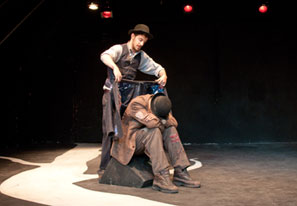
About two weeks after 9/11, I was sitting in a bar on St. Mark’s Place in Manhattan’s East Village. New Yorkers were still moving in slow motion, filing past the printed photos of victims on every corner. The bartender told me about an impromptu art space that had been set up on First Avenue, a few blocks away. That night my wife and I wandered into what appeared to be an abandoned school. The sound of live jazz poured from an antique auditorium, and candles lit the creaky stairs leading up and through the building. In every room, we saw paintings, photographs, and poems, along with shoes, refuse, and twisted metal from the wreckage. It was a surreal but beautiful place.
I often remember that art show when thinking about the Performing Arts Center at the World Trade Center, or PAC WTC as it is now known. The project has gone through several difficult permutations over the past decade. Of the four New York arts institutions originally slated to be housed at PAC WTC, only one, the Joyce Theater, remains, and with a greatly reduced role. The failure thus far to create a compelling vision for the PAC WTC is the result of an elitist, top-down approach from a board of directors more interested in international status than in serving the needs of New York’s artists and citizens.
Ever since the 9/11 attacks, New Yorkers have sought to use the World Trade Center site to celebrate our strength even as we mourned our dead. Now, in the shadow of the tallest building in the Western Hemisphere, the PAC WTC is poised to open by 2018, with David Lan, artistic director of Young Vic in London, serving in that capacity here as well. Lan’s challenge will be not only to create a diverse, multipurpose facility in the heart of the financial district but also to decide what kind of work should be performed there.
Setting aside the legitimate question of whether the job should have gone to an American rather than a Brit, the latest plans for PAC WTC look promising. The original proposal calling for a 1,000-seat mega-theater has been abandoned in favor of a plan for three smaller theaters, of 550, 250, and 150 seats, along with cabaret and cafe spaces. The three-theater plan emphasizes flexibility. Few arts organizations can pull off a show in a 1,000-seat house. As it is, a 550-seat house (about the size of most Broadway theaters) is appropriate only for the most elite organizations. Even filling a 250-seater is a tall order for a small theater company or performance troupe, while the 150-seat theater will offer opportunities for more modest enterprises.
Though Lan has said that PAC WTC is “for New York and New York artists,” he sees his main job as enabling “collaboration between American artists and people in Europe, China, South America, wherever.” New York hardly lacks for world-class arts facilities, of course. Lincoln Center, Carnegie Hall, Avery Fischer Hall, BAM—to name a few—all feature international stars. New York artists don’t need more access to the international glitterati of high art; what they need is an affordable space to create new work.
I have produced theater in New York for over a decade, and I know that thousands of artists would take advantage of the opportunity to work at Ground Zero. One model that PAC WTC should look to is Theater Row on 42nd street. A small, privately owned complex of five theater spaces ranging between 55 and 199 seats, the complex has a managing director but not an artistic director. Its spaces are simply available for rent—and rented they are, by theater companies of widely varying budgets and reputations. This focus on infrastructure, rather than artistic leadership, offers the best chance for PAC WTC to become a meaningful part of New York’s art world and perhaps even an exemplar for arts centers across the country.
PAC WTC should also look to another model in its attempt to create a vital new venue. Almost every major city in America plays host to an annual Fringe Festival. Now decades old, the Fringe model is useful because it has remained so successful. Fringe Festivals—the term was coined by playwright and journalist Robert Kemp, who wrote in 1948 that “round the fringe of official Festival drama, there seems to be more private enterprise than before”—are either uncurated or loosely curated. A commitment to private enterprise over artistic leadership has made the Fringe Festival one of the few bright spots in the last half-century of performance development. Most Fringe Festivals have more demand for participation than available slots. They offer a far better example of what PAC WTC can and should be than, say, Lincoln Center.
When financial risk for performance programing is shifted away from the institution and onto the artists themselves, successful and sustainable venues emerge. This approach is financially challenging for artists, to be sure—but artists flock to the opportunities that result. PAC WTC should be there for that kid in Queens who wants to pay a few thousand bucks to run her show, not because some British guy thinks she should, but because she thinks she can. New York already shares much of its performing arts with the world. The Performing Arts Center at Ground Zero should belong to us.